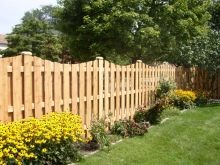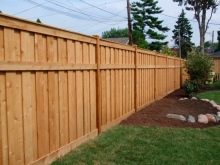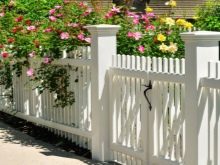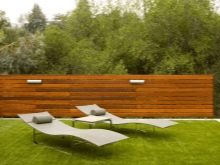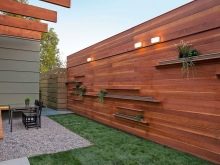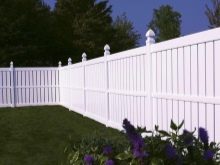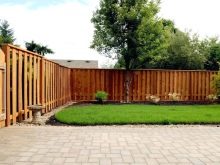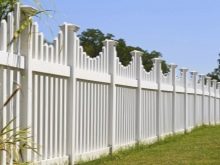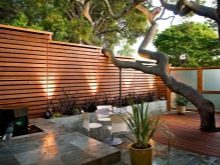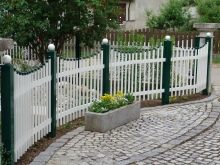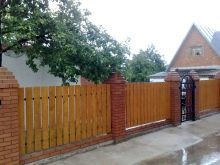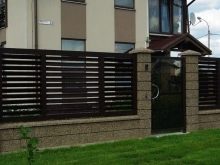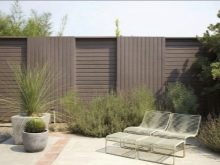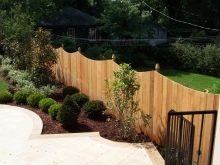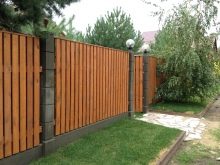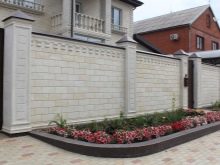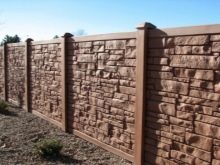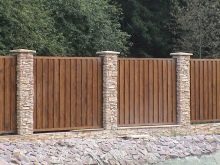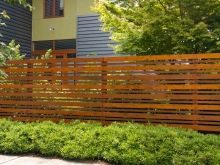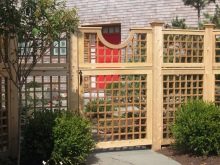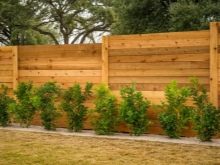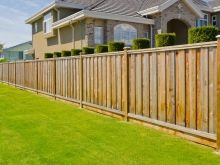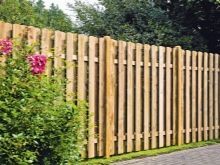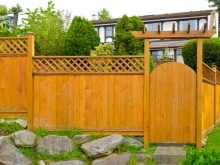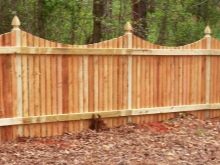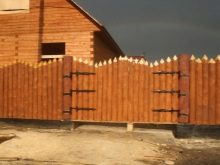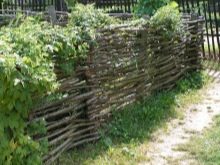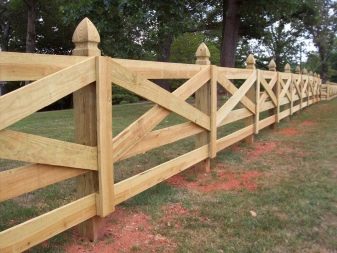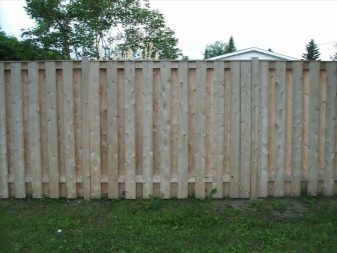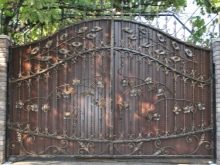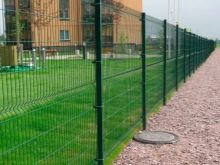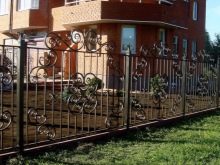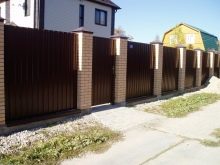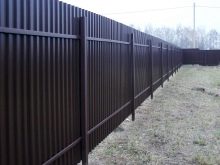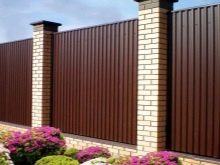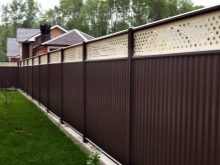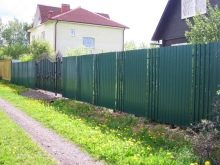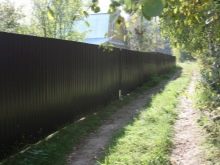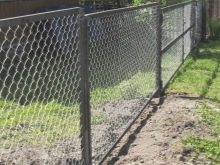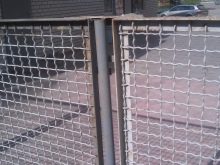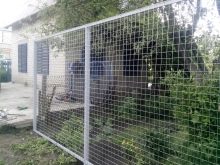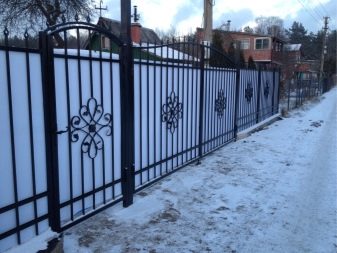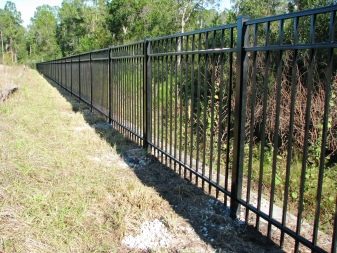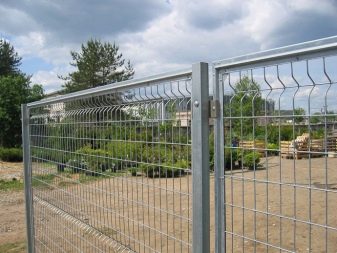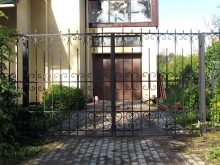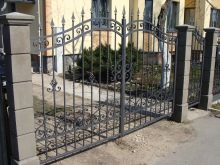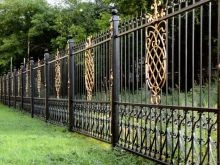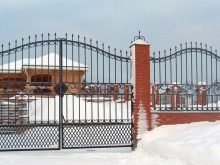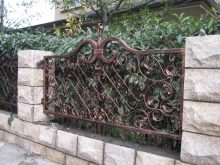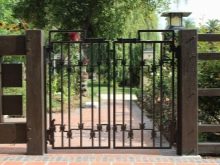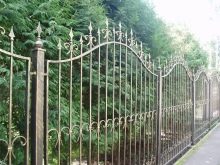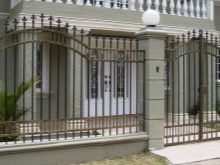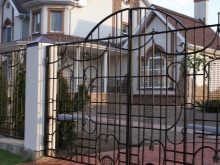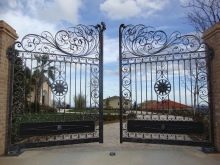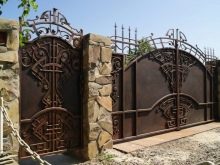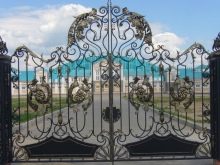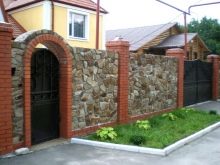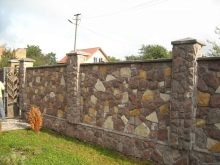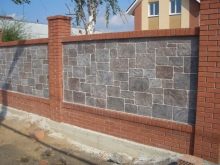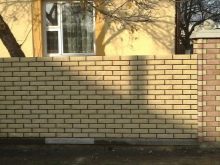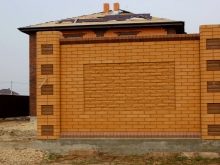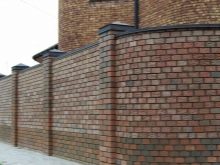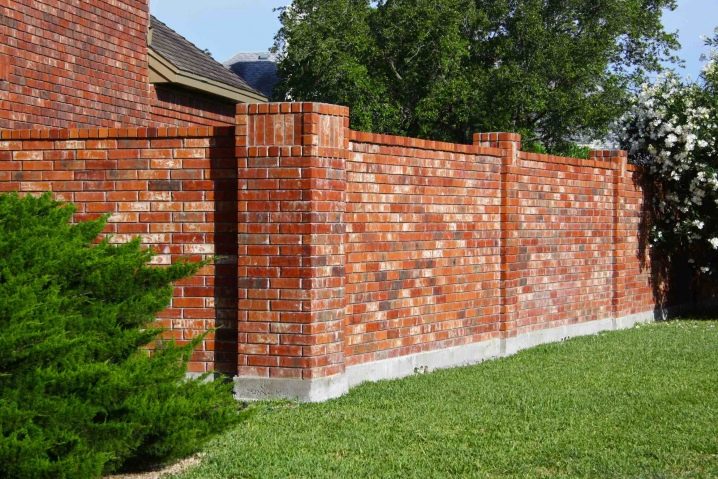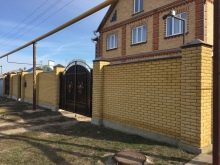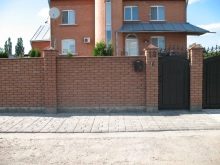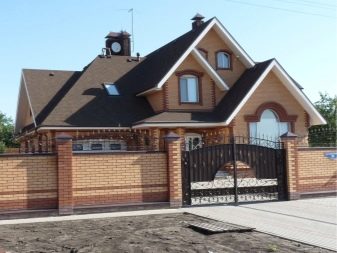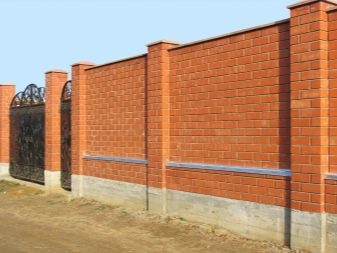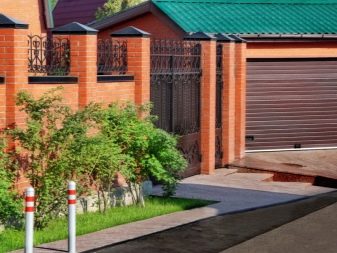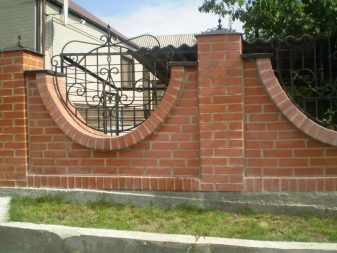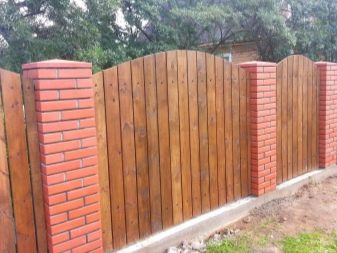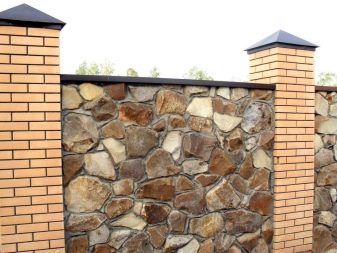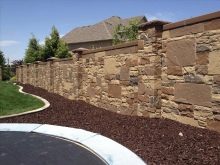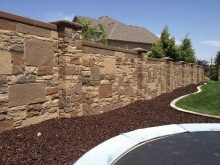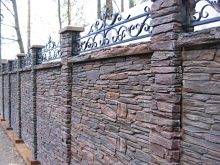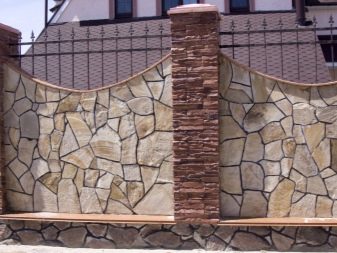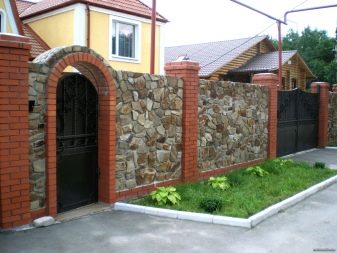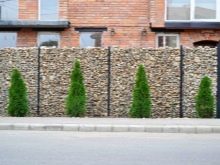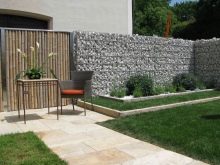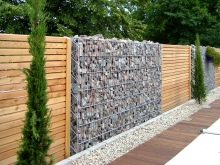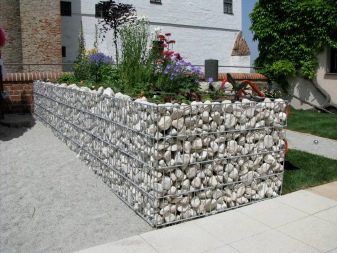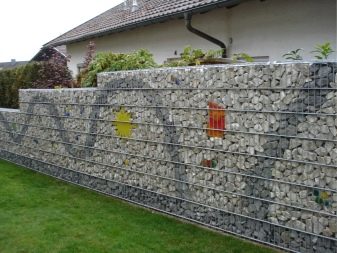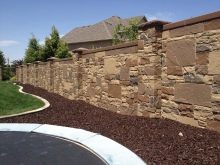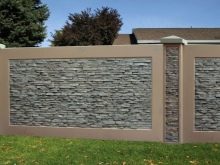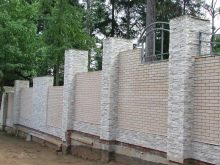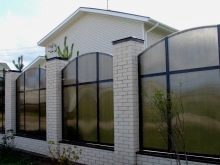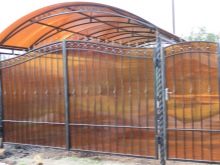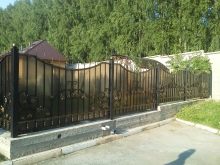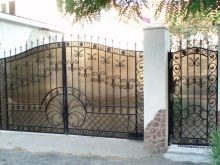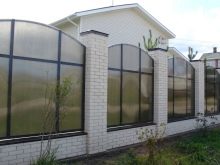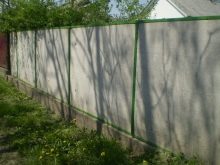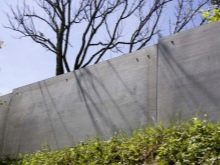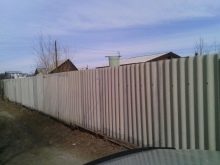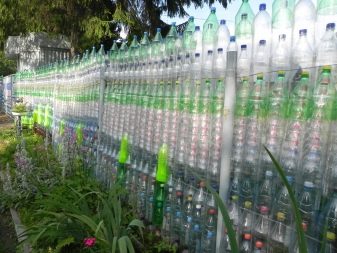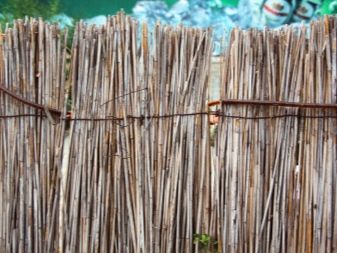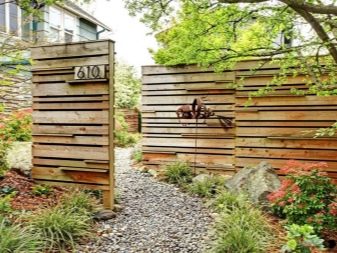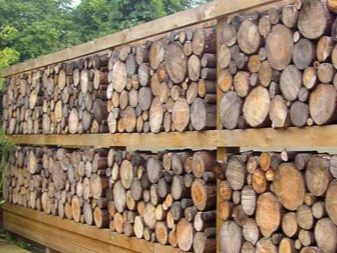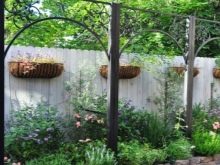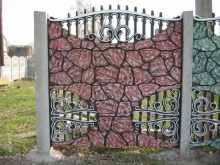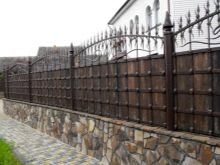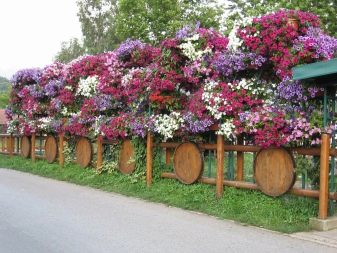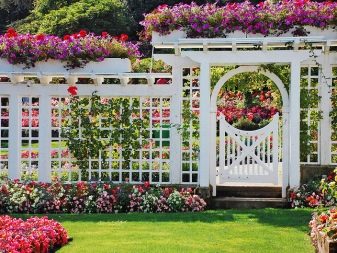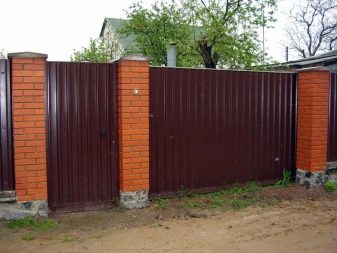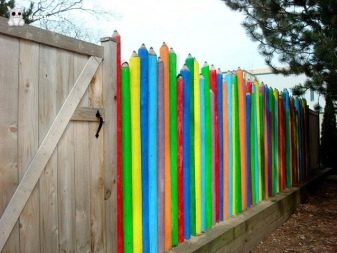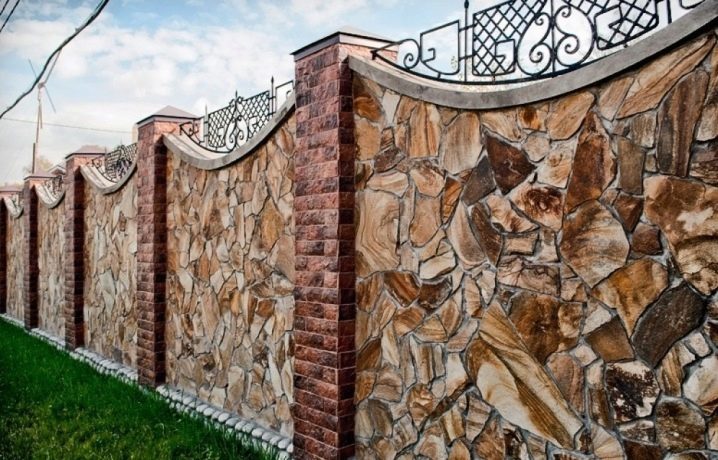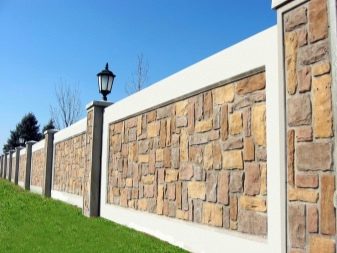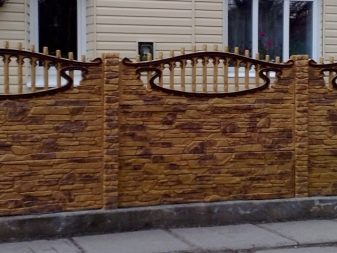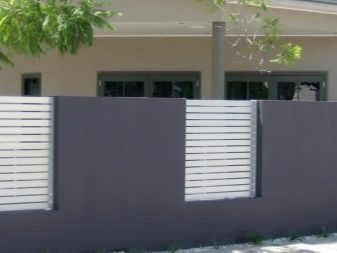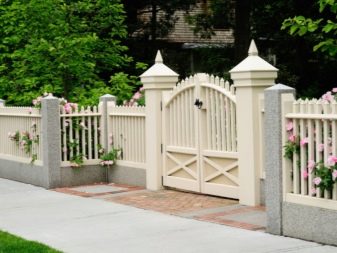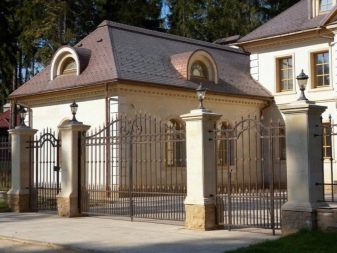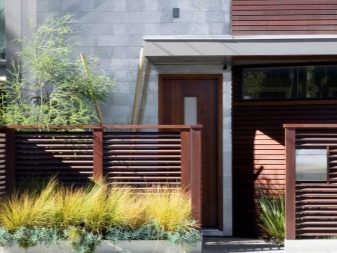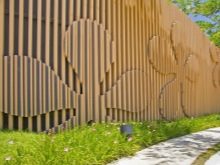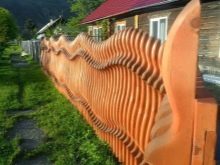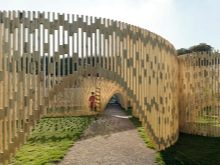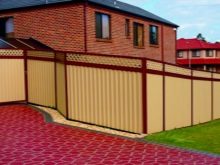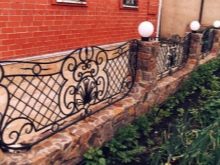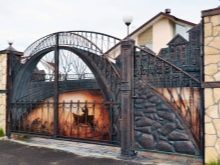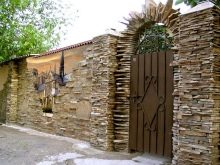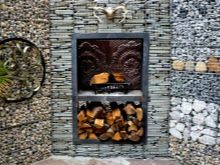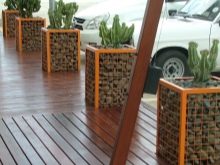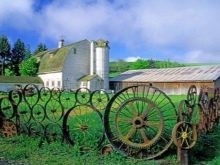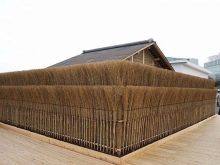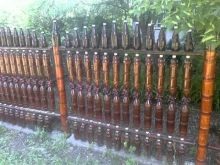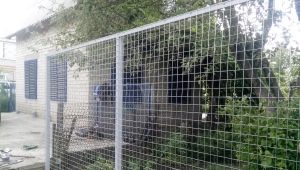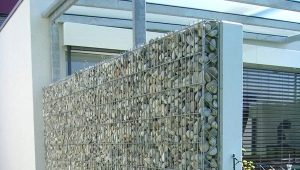Fence: main types of structures
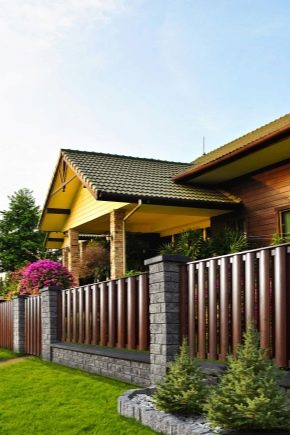
Owners of private houses delimit their territory with a fence. For country estates, this design is of paramount importance. Many first build a fence, and then build a house. It protects the site from prying eyes and the plundering of building materials. When the house is built, the fence for many years will serve the owner faithfully.
Features and Purpose
Fences have different purposes and look different. Protective function is performed by high and durable structures, and decorative delight the eye with its elegant forms. At a private house or cottage you can find hedges made of wood, stone, bricks, sheeting and forging. Non-residential, industrial areas enclosed concrete, metal products.
Functions of fences
Among the main ones:
- The designation of the border. If they are not fixed, a dispute over the territory will arise even between good neighbors. In this case, it is appropriate to say: "the higher the fence, the better the neighbors." It will be correct to put a fence immediately after surveying the plots in order to further eliminate conflicts. Buying land, you can build a solid fence. But if there are no funds, and it is necessary to designate a plot, any available means will do. All that is above the ground and clearly visible, can be considered a hedge. The line drawn on the ground with a shovel is not considered a fence. Borders are built and inside one site to highlight a vegetable garden or isolate pets.
- Protection. The fence becomes it for country houses, industrial and private enterprises, public institutions (schools, hospitals). The higher and stronger it is, the more reliably it performs its function. Owners of country sites for safety build high durable fences of profiled sheets, brick or stone. Concrete industrial fences do not look so aesthetically pleasing, but they perform their protective properties perfectly. Fences protect from prying eyes, stray animals, wind, dust.They are able to keep small children within their yard. Perform noise protection functions, being near the roads.
- A sense of privacy. A person should feel protected in their territory. This is not the physical security from penetration, rather psychological, at the level of sensations. The fence around the private territory gives you the opportunity to work and relax on the site without fear of other people's views, helps you feel yourself the master in your small, but very important world.
- Decorative features. The last decades the construction of country houses has intensified. People prefer to work in cities, and live outside the city. Instead of a garden and a kitchen garden, there are green lawn, flowers, decorative trees and other landscape design elements on the plots. Sometimes the owners build high, but open fences to show the beautiful courtyard to the neighbors. The base and pillars are built of brick or wild stone, and the fence itself is made of wrought metal openwork. Forging gives the fence lightness, it is diverse and beautiful. Fencing in such houses should be combined with all buildings on the site.For those who have a sense of beauty, but who cannot afford a wrought fence, it’s quite realistic to install a beautiful fence from the side of the street and plant climbing plants along it.
Wooden fences are unusually beautiful, but they are also expensive. Budget fencing can be decorated with flowers. The hedge looks natural and aesthetically pleasing.
- Constructions. Fences are built in different sizes and shapes, but cannot be distinguished constructively. They all consist of load-bearing elements and plating. The pillars and horizontal girders make up the frame of the fence and are the supporting structures, they fasten the sheathing of any fence. The fence can be deaf or viewed as a chain-link mesh. The material for fences is different: brick, stone, wood, plastic, cast-iron gratings, but the principle of installation is the same for everyone.
- The trim should be in harmony with the rest of the buildings. For example, if stone and forging are involved in facing a house, a garage, a gazebo, garden benches, the fence will have to comply with the overall design. For old houses or country options, you can select a fence according to other criteria.Sometimes natural factors contribute to the rules. The choice of design may affect the soil. Sandstone, clay and other types of soil in different ways retain supporting structures. The depth of the foundation and the severity of the product itself depend on this.
- Building a fence, it is necessary to take into account the wind rose. The open steppe relief involves a large load; here the foundation should be strengthened. Fence to make capital or leave gaps between the elements to increase the resistance to wind.
- Functional necessity also influences the design.. If the fence is considered as a contour of the territory or a barrier for children and animals, it is built low, but durable. Fencing from thieves and a stranger's gaze is built taller than a man’s height, and stronger materials are used for it.
- A good foundation is the key to a durable fence.. It is made of two types: with the participation of pillars and tape. For the tape version, dig a ditch, fill it with rubble, install a frame and pour concrete. If the fence section, expose the pillars at the right distance. For the pillar foundation there is no need to pour concrete around the perimeter of the fence.It is enough to dig pits of half a meter depth at the distance of the length of the spans of the fence. Each pillar is measured by level and poured with cement.
Types of materials
The market offers all sorts of materials for the installation of fencing: from forged expensive lattices to budget options from the chain-link mesh. When purchasing a fence, you should immediately think about what gate and gate it will be equipped with.
It is better to buy everything together to keep a single style.
Brick, wild stone or wood will cost more. You can save money and build a high fence using slate panels, and eventually it will become clear that fragile material requires frequent repairs. In order not to be mistaken in the choice, we will try to consider in more detail the types of materials.
Wood
Wood is one of the most ancient building materials. The centuries-old practice of working with it and the accumulated experience helped to develop and improve many options for fencing: from a simple picket fence to expensive carved products. Wood, like any other material, has its positive and negative sides. The positive ones include:
- In our country, wood is readily available and affordable.
- The natural structure of the tree makes it pleasant to be near it. If you put a bench in the shade of a high fence, the rest will be more complete than the wall of corrugated board.
- Wood is the softest building material. It is easy to work with him, so woodcarving masters create their masterpieces from it.
- Wooden fences are able to surprise the possibilities of the color palette. Even unpainted fences from different breeds of plants look different. They are enough to process the stain or special impregnations to emphasize the structure of the tree. Fans of bright fences can use paint.
As for the negative sides, there are not many of them, but for the sake of justice, we should say about them:
- the fence is not durable, as wood is subject to environmental influences;
- annual care: the fence will have to be painted or treated with insect repellents;
- amenable to mechanical stress, breaking, which reduces the protective properties of the fence and increases the cost of repairs.
Assessing the advantages and disadvantages for an objective choice of material, you need to understand the types of structures:
- Fence - fence, which consists of wooden slats, arranged parallel to each other. It can be slatted, of different size and shape, both natural tones and colored. It is easy to decorate with carvings or patterns. It is beautiful, airy, but it has no special protective function.
- Palisade - The fence of wooden stakes, which are tightly hammered to each other. To enhance the protective properties of the upper edges sharpen, like a pencil.
- Scourge - the most economical fence, it is made of wicker branches. Widely used in the old days. It can be horizontal when the twigs are intertwined through the pillars driven into the ground, and vertical - when the branches stand lined up in a fence.
- Fence ranch Came to us from American cattle breeders. The design requires less material than a deaf fence. It is made from unedged board or timber. Used for corral cattle. There are more cultivated types of hedge: they consist of even painted boards. They are placed in places where decorative fences are needed. For ranch fences, the horizontal directions of the slats, which are attached to vertical supports, are characteristic.
- Board fence is a vertically lined boards of the same length, fixed to horizontal crossbars. It differs from a shtaketnik by a continuous covering. Such fences can have a great height, which makes it possible to protect areas from prying eyes.
Metal models
Metal fences are used for various purposes and they cost differently. Grids are among the cheapest materials. In the private sector, they are used for protective purposes, not relying on protection and privacy. The most expensive structures include wrought iron products: they are made by hand at the request of the customer. Such fences have an expensive and presentable appearance.
Decking
The professional leaf represents a metal cloth with corrugations. They make the material sustainable. It is used to protect private and industrial areas. High fences of corrugated flooring hide the courtyard from prying eyes. It protects against thieves, but with a strong mechanical action can be destroyed: it can be cut, cut with an ax. This functional material has many advantages:
- it is lightweight, self-assembled;
- durable, its service life up to 50 years;
- it is simple to look after a fence;
- fire resistant;
- in case of damage, the sheet can be easily replaced;
- thanks to a special coating, resistant to environmental influences;
- large selection of colors allows you to combine with the material of the roof of the house or other buildings;
- a high fence protects against dust, wind, stray animals and uninvited guests;
- acceptable price.
You should also pay attention to the disadvantages:
- rustic appearance;
- in violation of the antimicrobial layer, the material begins to gradually deteriorate under the influence of the external environment;
- able to deform under strong shock;
- heated by the sun.
When choosing professional sheets for the fence, you can order the same material for the gate and gate.
Metal grid
Today the grid is one of the most economical materials. It is used for land surveying. The product is produced in different sizes: with several types of cells, vinyl or galvanized coating. The most durable steel mesh with electroplated coating. With proper care, a hedge can last up to thirty years. Metal mesh can be of several types:
- Chain-link. It is made of wire, has a different thickness, the size of the cells and the coating (for painting, polymer, galvanized). It is easy to install, welded or nailed to the supports. You can buy ready-made modular designs on the frames and install between the pillars. Plants grow well near the fence, as it does not cast a shadow. The size of the structure is quite high, it will not be possible to jump over it.
- Corrugated. Consists of a bent wire, up to 0.8 mm thick. The perpendicular weaving of the grid provides special strength, so it can be tied between supports that are five meters apart from each other (for a chain-link it is three meters).
- Welded. Such grid is more expensive than corrugated and chain-link. It looks attractive and easy to install.
If vines are planted along the fence, the unsightly metal mesh will turn into a blooming hedge.
Welded steel structures
Cast or stamped parts are welded to the prepared frames, forming an independent pattern. This type of fence in appearance is inferior to forged, but it is easier to produce and it is cheaper. Among the shortcomings - the complexity of painting.
It is not necessary to paint the fence from galvanized bar, it is welded from steel parts coated with polymer and protected from corrosion.
Forged
Forged products are elegant, unusual, they are a decoration of landscape design, perform protective and decorative functions, report on tastes and wealth of the owner. The carved fence is well combined with modern brick or wild stone, it is combined with corrugated polycarbonate. The laboriousness of the handwork and the difficult painting erect forged fences to the rank of the most expensive.
They are high, have good protective functions, but the transparency of openwork forging cannot protect from prying eyes. Sometimes, respectable homeowners set them up specifically to boast a landscape design of their plot.
Fences with forged elements are divided into three groups - utilitarian (practical category), decorative and intermediate:
- Utilitarian fences are used to protect the site, the decorative elements on them are virtually absent, and if they are, they are exclusively stamped. They are produced by the method of cold forging: the parts are bent and twisted on special equipment,then weld into certain sections. Stamped fences have a lower cost and are available to many homeowners.
- Decorative work often ordered individually. They are created by masters of artistic forging, who for years acquire skills. When creating such fences, welding work is minimized: the parts are connected using clamps and rivets, stamping is not allowed, all elements are made by hand. Exclusive products become real works of art and are very expensive.
- Intermediate types of complexity of manufacture and price range are between utilitarian and decorative. Welding in such structures is partially involved, artistic elements are present, but to a greater extent they are stamped. Products look decorative, have all the functionality and are cheaper than artistic forging.
High forged fences are built around the perimeter of the site, inside the courtyard they use low fences as curbs, they allocate flowerbeds, lawns and other landscape design elements. Forging, like other hedges, has its advantages:
- amazing beauty of the product;
- the exclusivity of highly artistic forging, which makes it possible to produce it according to the customer’s project;
- forged products are durable and durable, they are resistant to strong mechanical stress;
- the height of the fence allows it to cope with its protective functions;
- hedge, made according to the rules and covered with an antibacterial layer and paint, does not require careful maintenance, it is enough to paint over scratches in a timely manner.
As for the shortcomings, they also exist and you should be aware of them:
- the high cost of the product makes it inaccessible;
- when damaged, a special layer of corrosion occurs;
- long manufacturing process;
- such a fence cannot protect from prying eyes, wind, dust and noise, unless it involves professional sheets in the creation of the fence.
Stone and brick
Fences made of stone and brick look durable and beautiful, and if you add to them forged structures with openwork ornament, fences become fantastically spectacular. Fences made of stone and brick are made thoroughly and need a reinforced concrete strip foundation. Stand such a structure will be at least half a century.He will not be afraid of any weather conditions.
For the cottage and the blockhouse, built of brick, you will need fences of the same material, so as not to disturb the style of the site.
Brick fences
Brick color, structure, size and brand frost resistance is divided into three types: clinker, ceramic red and silicate white. The material should be chosen according to the technical characteristics intended for those climatic conditions in which the laying will be located. For the construction of a fence, use a special dry mixture, which during installation does not leave marks on the surface of the product. In working with clinker bricks, you can choose a solution of a suitable color from the sixteen existing species.
Particularly popular today are the brick blocks, made under crushed brick.
Fences from this material have a number of positive characteristics:
- they do not need unnecessary care and annual coloring;
- reliable construction protects from wind and dust, able to withstand any environmental conditions;
- the fence is strong if it is laid out in one brick, and the thickness of three bricks will withstand even a car hit;
- solid fence creates an atmosphere of privacy;
- decorative types of fences, especially combined with wood, stone or forging, give a good taste and material capabilities of the owner;
- brick masonry is durable and can serve several generations;
- security functions of the fence depend on its height and shape: the higher and wider the structure, the safer it is.
Among the shortcomings can be said about the high cost of the fence. Installation takes more time than other types of fencing. Brick - a universal building material that is used in many areas. As for the country houses, he can participate not only in the construction of the cottage, but also in all the buildings on the plot, right down to the benches, garden paths and curbs for flower beds.
Brick fences are built capital, using concrete blocks. Monolithic fences exclude the participation of concrete and are traditionally made of brick. Despite the homogeneity of the structure, they do not look boring. You can diversify them with blocks of different colors, lay out an ornament or change the tones in a checkerboard pattern, equip them with peaks.Decorated with arches and niches for flowerpots, fences gain ease and become part of landscape design.
Versatile brick features allow you to perform combined fencing. You can achieve a variety of forms by building fences with the participation of a multi-pattern construction material. The most expensive of them combine brickwork and wrought iron. Forging is done by hand and has artistic value. To reduce the price of such products by applying stamped elements.
Wooden inserts are well combined with a brick wall. They are beautiful and original, they feel the design intent. Such a fence has protective features.
Of particular strength are brick fences combined with stone. Psychologically, behind such a fence, you can feel like in a fortress. The fence looks amazingly impressive, combining the precise geometry of a brick and the free shape of a stone.
Stone fences
For the arrangement of the home stone was used by ancient people. This gives reason to consider it the oldest building material. Such a fence will never rot; it will not be spoiled by corrosion.Frosts, wind, rain and hail will not cause him any harm. The stone is well combined with other building materials, it is architecturally expressive and fits into any landscape design. A large number of varieties of stone will allow you to choose it to the taste of the customer. Here are some of the most popular ones:
- Boulder stone (cobblestone) is the most affordable and durable material, sold mostly gray shades.
- Limestone has varieties: marble, bryozoic and shell rock. It is a soft, malleable material, easy to work with. The disadvantage is the instability to moisture. Helps pre-treatment with a water repellent.
- Sandstone has long been used for fencing, it is moisture-resistant, strong and not subject to frost.
- Dolomite is mined in mountain quarries, it is flat and different in thickness. Fences from such material are strong and reliable.
- Booth is not pronounced, it is mined from dolomites, limestones and sandstones. It is popular as a facing material, but it can also serve as the basis of a fence. A product made of rubble looks original and thorough, but its installation is quite complicated and requires the work of a professional bricklayer with a special tool.
- Gravel is often used in fences independently and in combination with brick, and also combines large and small stone.
- The artificial stone is very popular: it is produced on the basis of concrete with the addition of pigment paints. The appearance of this product is difficult to distinguish from natural material.
Stone fences have the same advantages as brick. They are strong, reliable, durable, eco-friendly, they are not afraid of fires. A large range of prices makes them affordable for people with different incomes.
When building a fence, a linear foundation is required, as well as a preliminary study of groundwater and precipitation.
The stone is well combined with other types of materials. In combination with wood, it looks especially harmonious: such a fence on a country site is completely dissolved in the natural environment.
The most popular stone in combination with brick. He participates in the construction of pillars and the base of the fence.
Recently began to appear fences, equipped with a stone in the nets. The so-called gabions and pergons. These two species have a fundamental difference: a gabion rests on its massive foundation due to its own weight, for example, a construction that is more than two meters high must have a base of at least one meter.For the pergon make stand for the usual fence, which hold the design.
Mesh containers are made of thick wire in factories, delivered to the construction site and already filled with stones (gravel, rubble, pebbles and others). Installation is easy: even one person can handle it. If desired, the design is dismantled and assembled in a new place. With the help of grids of various sizes, the charging intake can take various forms. The stone "comes alive" if you plant climbing plants next to it. Such a fence will organically merge with the natural landscape.
There are narrow and low mini-pergon, they are used inside the site, for example, for the walls of gazebos. With their help, they delimit the flowerbeds, zone the territory, carry out various design ideas.
Gabions and pergons have a lot of advantages: they are strong, durable, able to change their design according to the designer's plan, they are easy to dismantle and place in another place.
Fences made of mesh with fillers combined with wood and brick.
Artificial stone is difficult to distinguish from natural, on the market it is represented by three types:
- Porcelain stoneware made from clay and mineral additives under very high pressure involving high temperatures. Externally similar to ceramic tiles, only much stronger. Used for outdoor use, but sometimes used indoors.
- Agglomerates A polyester resin is taken as a basis, a crumb of a natural stone is added to it. Produced mainly for the production of furniture.
- In building artificial stone Concrete is used for wall cladding. To it add a various crumb (expanded clay, pumice, the painting pigment). The solution is poured into molds to imitate natural stone, then subjected to vibration and pressure. Artificial stone is difficult to distinguish from natural.
From such material surprising fences turn out. There are fences made under the crushed stone from the blocks Besser. By durability such fences are inferior to natural material, but they are just as good and aesthetic.
Polycarbonate and plastic
Polycarbonate is a carbon-based synthetic polymer. It is one of the latest developments in building technology. It is a beautiful transparent material, flexible and durable, with a wide choice of colors.It is used in the construction of greenhouses, greenhouses, for the manufacture of peaks and fences. Panels are noise-proof and act as protective screens. Such a fence is indispensable near the highways.
For fences on the site polycarbonate goes as the main and combined material with metal, wood, brick. The openwork pattern of forging is beautifully filled with air polymer. The material is lightweight, weather resistant, does not fade in the sun, suffers blows.
Although the polymer is 80 percent transparent, it is impossible to clearly consider what is happening behind the fence, all the outlines are blurred. Large selection of colors allows you to pick it up in the tone of buildings in the estate.
Installation is somewhat difficult, as it requires the participation of high temperature. The polycarbonate sheets are flexible and lightweight, they can break loose due to strong winds, so installation should be done with special responsibility.
Slate fencing
Slate fences are more often installed at summer cottages when the roof is being changed and it is possible to save on fencing. If you buy a new slate, it will look good as a hedge, it can be painted the color of the roof or walls of the house.Slate does not rot, does not burn, protects from wind and dust, but has its disadvantages. It is fragile to mechanical stress, weighs a lot, blackens from damp. It can not be called environmentally friendly due to the presence of asbestos.
Wave slate overlap on the horizontal wooden crossbars connecting the fence posts. Flat is inserted into a metal frame or corners.
From scrap materials
There is an opinion that the fence can be built from anything, you just have to look at the environment, and the people have enough imagination and creativity:
- It is interesting to see a fence of two-liter plastic bottles. They are set in five rows and fastened between wooden posts. Such sections should be enough for the entire fence.
- The most popular improvised means that our ancestors used were branches and reeds. They make wonderful wickers that can decorate any part.
- Wooden pallets are used as fencing: they are painted and installed in country houses, receiving an imitation of a ranch fence.
- There are peculiar fences in the form of a woodpile: they look beautiful and there is a supply of firewood in winter. Logs can be laid in gabions or fastened in any convenient way.
So from nothing, almost out of garbage, a beautiful construction appears in the form of a fence, which surprises with its ingenuity.
Decor
The main task of the fence is a protective and separation function, but the simple laconic fence looks boring. If the owner is an esthete, he will make the fence delightful, but for a person with a sense of humor, the fence will be fun and creative.
There are various ways to design a fence: the design uses lights, flowerpots, statuettes, forged items, original coloring, colored glass, garden plants. Beautifully looks low air fence of wooden planks with alternating stained glass and through-voids.
The simplest way to decorate a fence is to let the climbing plants do everything on their own. This is an indispensable solution for the mesh netting.
Flowers will help not only to hide the unsightly design, but also to hide the yard from prying eyes.
Decking was originally used for industrial enterprises, and today it has firmly entered the life of the private sector. To make the canvas attractive, paintings are drawn on it: from small patterns to complex plot images.For greater effect, the professional sheet alternate with brick pillars. Black edging will give it elegance, and if you paint the material under a tree or brown brick, it will be very difficult to know what the fence is made of.
Of great importance is the color of the fence. It must be in harmony with the roof and facade of the house. For example, the blue fence goes well with the gray walls of the building. The paling along the contour of the playground can be painted with all the colors of the rainbow. The elegant white color of the concrete fence (“eurofence”) requires frequent maintenance, and by painting it with different shades, you can get a beautiful and practical fence.
A pompous stone fence with brick inserts is decorated with facade lights, if the same decorate the main entrance of the house. A beautiful, but expensive solution is to decorate the fence with arches with sculpted figures inserted into them.
A fence can tell a lot about its owner. At first glance, you understand who lives behind it: hardworking, or lazy, with prosperity, good taste or with a sense of humor.
Tips for choosing
The land owner needs to understand what functions the fence should have. To designate the boundaries of the mesh is enough.The feeling of security will give a high durable fence made of brick or stone. A fence of profiled sheeting will be able to protect, but it is not as reliable as a stone, and is a budget option. For the protective function, a beautiful and relatively inexpensive concrete fence will be suitable. It can be both deaf and open, light, decorative.
Concrete fences are produced in a wide range of colors with a relief pattern. For aesthetes need highly artistic fences involving forging or carving.
Having ascertained the practical component, one should pay attention to the combination of the fence with the manor and the house. Therefore, when choosing a building material for fencing, the style of landscape design is taken into account. Let's try to understand this issue:
- Style high tech in the design of household plots became known not so long ago. His innovation is different from other styles. At this site should be all the most modern: smart watering, lighting, as well as a swimming pool and unusual buildings of ultramodern material. Glass, metal and wood are involved in the decoration of the garden and the fence. Decorations are strict, no frills: everything must give the garden a new generation.
- In contrast to high-tech with his know how, style provence charms simplicity and naturalness of rural life. Only natural materials are used. The arbor is made of stone and poorly treated wood.
The design of the fence and all the buildings involved only soft colors: white, blue, gray, pink.
- Landscape Design in traditional style restrained, with clear, straight forms, shrubs shorn, garden paths flat, straight. The fences are light, no frills, but small sculptures are allowed.
- Style modern - the exact opposite of the traditional. No straight lines, everything is smooth and natural. Sections of fences can be of different heights and go along the section with rounding, without strict rules.
It is impossible to describe all the styles, but it is quite acceptable to talk about the combination of the stylistics of the landscape plot and the fence.
Beautiful examples
Fences are not only protective, but also decorative. When you see intricate beautiful fences, you involuntarily think that there is an even more magnificent view beyond the gate. To avoid disappointment, you must adhere to the main rules of landscape design: the fence should not be more beautiful than a cottage and a local area. The ideas of some fences amaze with their originality:
- The fence of wooden slats is decorated with patch flowers, highlighted by the contrast of the stripes.
- Fence in the style of modern. Every detail of the hedge has been processed and rounded off with great love. In this case, the fence turned out to be more magnificent than the buildings that are viewed behind it.
- A masterpiece of design art. High, but at the same time, an air fence with arches and isolated roundings resembles a labyrinth. It seems that everyone will find a secluded place here, but the transparency of the walls does not make it too personal.
- If you properly organize the fence of corrugated sheeting, he can decorate even a wealthy manor.
- An example of a combined stone fence with openwork forging and decorated lanterns.
- The art unique forging created by the professional. The fence with the gate is a single canvas of the master.
- A fence made of natural stone with visors and decorative pictorial insert.
- The place for rest and cooking shashlik is decorated with gabions with different fillings.
- Gabions with cacti. The fence is conditional, but the combination of wood, stone and living plants looks perfect.
- A fence of old wheels can be used to design a plot in the style of a loft orrustic style.
- Original broom fencing is a beautiful solution for a country house or country house.
- The fence of a simple, well-chosen material looks elegant and beautiful.
The above examples of original fences will help turn on the imagination and reflect on what is hidden behind the fence.
How to make a fence from a professional flooring with your own hands, see the video below.
